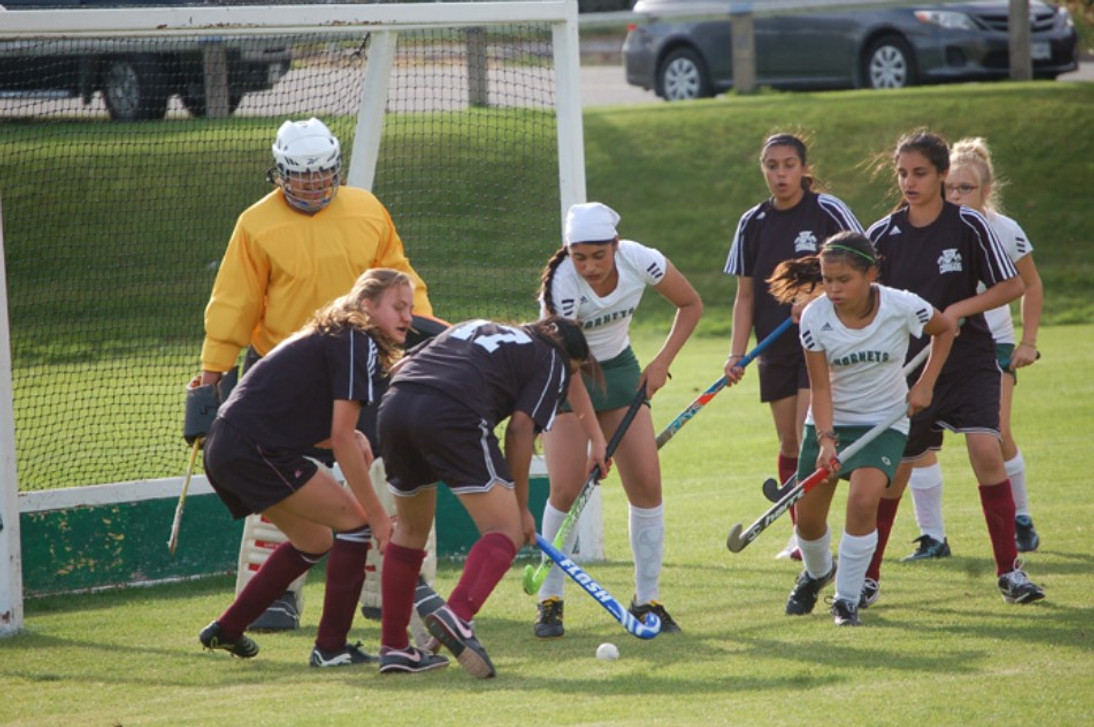When buying a field hockey stick the most important parameters to consider are: stick length, skill level, weight, composition, toe design, and the bow.
Stick Length
When purchasing a stick for your child, the most important consideration is stick length. Generally, the stick should come up to their belly button. However, stick length can also be a personal preference. For example, a defensive player may prefer a longer stick for long down field hits whereas an offensive athlete may prefer a shorter stick for better ball control.
Here’s a basic player height to stick size guide:
Player Height Stick Size
4' & Under 28"
4'1" - 4'3" 30"
4'4" - 4'6" 32"
4'7" - 5' 34"
5'1" - 5'3" 35"
5'4" - 5'9" 36" - 36.5"
5'10" & Over 37" - 37.5"
Stick Weight
Stick weight is generally based on a player's position and personal preference.
Light sticks are mostly used by offensive players for quick wrist movement and overall quicker stickwork. A lighter stick also facilitates flawless ball reception. Adult athletes who typically play forward prefer a lightweight stick weighing less than 21 ounces. Midfielders, who play offensive and defensive tactics, generally prefer sticks weighing 21 ounces.
Heavier sticks are used by defenders to add power and distance to hits and are more durable. weighing 22-24 ounces.
Skill Level
Field hockey sticks are categorized into 4 different skill levels, beginner sticks, competitive/intermediate sticks, advanced sticks, and elite sticks.
Beginner sticks are entry level sticks that are designed to help develop basic skills with a focus on ball control. Beginner sticks are ideal for young players who are learning fundamental skills. Generally, beginner sticks are constructed of either fiberglass or wood with a low power level. These sticks are recommended for players age 10 and younger, or for players playing for less than one year.
Competitive/Intermediate sticks are also designed for ball control but with an added element of power. These sticks are typically constructed with less than 20% carbon, offering less vibration compared to sticks with higher carbon counts, but still providing adequate power for the developing player. Competitive/Intermediate sticks are recommended for players ages 10-13, or for players with 1-2 years of playing experience.
Advanced Sticks provide the best of both worlds for the progressing player. These sticks offer an even balance of power and ball control allowing players to continue their development. Advanced sticks typically contain less than 70% carbon for a softer touch and increased control. Advanced sticks are recommended for players age 13 and older with 2 or more years of experience.
Elite Sticks are the cream of the crop. Elite level sticks are at the cutting edge of innovation and technology. They are designed for highly skilled players looking for increased power paired with precision. Typically, elite sticks are made with 70% to 100% carbon to maximize power without sacrificing touch. Elite sticks are recommended for players age 15 and older with 3 or more years of playing experience.
Composition
The most popular materials used in field hockey sticks are Carbon, Aramid, Fiberglass, Graphene and Wood.
Carbon Sticks: Carbon adds a significant stiffness to field hockey sticks. The higher the percentage of carbon in a stick, the greater the power output.
Aramid Sticks: Aramid adds strength to the stick, while also dampening vibration.
Fiberglass Sticks: Sticks are fortified with fiberglass to add durability, strength, and increased ball speed. Fiberglass also helps dampen stick vibration.
Graphene Sticks: Graphene is a single layer of carbon atoms, tightly bound in a hexagonal honeycomb lattice to provide greater energy transfer, shock absorbing properties and performance.
Wood Sticks: Of all the field hockey stick materials, wood offers the least amount of stiffness. Still, some players still prefer the touch and feel offered by a wood stick. Wood sticks are great for developing players.

Toe Design
There are four basic field hockey stick toe shapes; Shorti, Midi, Maxi, and Hook. Toe designs are constructed based on the different ways each position strikes the ball. Here's a brief guide on each toe design:
Shorti Toes are the most common toe design and are primarily used by offensive players. A Shorti Toe allows players to quickly turn the stick over the ball. Shorties also promote control, balance and maneuverability.
Midi Toes are approximately a half-inch longer than shorti toes and provide a larger hitting surface. for easier ball flicking, receiving and reverse play. Midis are ideal for beginners and midfield players.
Maxi Toes combine the extra receiving surface of the j-shaped hook toe with the hitting power of the midi toe. Maxis are excellent for drag-flicks and reverse stick control. They are popular with defensive players and are well-suited for grass fields.
Hook Toes feature a J-shape design and are made with a two-piece head that provides an extra surface area for increased ball control, better drag-flicks and reverse stick play.
Bow Design
A Regular Bow is typically a 20-22mm curve, with the highest point of the bend falling directly in the middle of the stick. A regular bow helps to maximize control and power, making it versatile for all field hockey positions.
The curve of a Control Bow usually ranges from 22-23mm. The peak of the bend falls closer to the toe, allowing for better power when lifting and drag flicking the ball. A control bow is ideal for advanced players.
The bend of a Late Bow or Low Bow typically measures around 24-25mm. The curve is primarily at the end of the stick, right before the head. A late bow allows elite players to control, lift, drag flick, and perform aerials.
Indoor Field Hockey Sticks
Indoor field hockey sticks feature a thinner and lighter design than outdoor field hockey sticks. Because the indoor game is played on a smaller, hard and flat surface, the rules prohibit hits, lifting the ball or big backswings. Thus, indoor field hockey sticks are less stiff than the sticks used outdoors.
Bow Design
The most common bends/bows of indoor sticks is the Regular or Control bow due to the indoor rule of the ball having to stay flat on the ground during open play.
Composition
Wooden Indoor Sticks are made for players of any level due to the soft touch and feel, which is ideal for indoor hockey.
Composite Indoor Sticks are made for players that want the feel of outdoor hockey stick. If you want a composite indoor stick to go for low carbon again to keep as much touch and feel within the stick as possible. Remember: You can't hit the ball for indoor hockey, so the carbon can't help generate the power!
Field Hockey Sticks can all look the same. Having your stick identified with your name and number is also important. Check out our field hockey stick decals at Stinky Lockers.


 USD
USD
 USD
USD
 Canadian
Canadian


